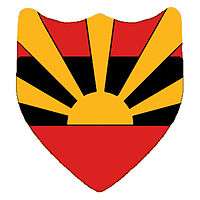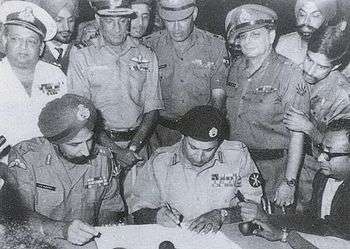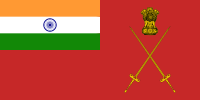Eastern Command (India)
The Eastern Command is one of the six operational commands of the Indian Army. It is headquartered in Fort William in the city of Kolkata in the state of West Bengal. The Command's Area Of Responsibility (AOR) extends from Bengal to Sikkim and then across the entire Northeast India. The Command shares international boundaries with the countries of Nepal, Bhutan, China, Myanmar and Bangladesh.[1]
| Eastern Command | |
|---|---|
 Eastern Command's insignia today. | |
| Active | 1920-Present |
| Country | |
| Branch | |
| Type | Command |
| Size | ~300,000 soldiers |
| Headquarters | Lucknow (1920-1963) Kolkata (1963-Present) |
| Engagements | World War II Sino-Indian War Indo-Pakistani War of 1971 2020 China–India skirmishes |
| Commanders | |
| Current commander | Lt Gen Anil Chauhan, UYSM, AVSM, VSM, SM |
| Notable commanders | Field Marshal Sam Manekshaw General Paramasiva Prabhakar Kumaramangalam Lieutenant General S. P. P. Thorat General Arun Shridhar Vaidya General Vishwa Nath Sharma General Vijay Kumar Singh General Bikram Singh General Dalbir Singh Suhag |
The Eastern Command was formed on 01 November 1920.[2] The Command is commanded by a Three Star General Officer of the rank of Lieutenant General with the title General Officer Commanding-in-Chief Eastern Command (GOC-in-C). Lieutenant General Anil Chauhan is the current GOC-in-C, who took over on 1 September 2019.[3]
History
The Presidency armies were abolished with effect from 1 April 1895, when the three Presidency armies became the Indian Army.[4] The Indian Army was divided into four Commands (Bengal Command, Bombay Command, Madras Command and Punjab Command) each under a Lieutenant General.[4]
In 1908, the four commands were merged into two Armies (Northern Army and Southern Army): this system persisted until 1920 when the arrangement reverted to four commands again (Eastern Command, Northern Command, Southern Command and Western Command).[4]
On 1 November 1920, the Eastern Command was formed, with its summer Headquarters in Nainital and winter Headquarters in Lucknow. General Sir Havelock Hudson, KCB, KCIE was the first Army Commander.[5]
World War II
In 1942, the command had the following formations under it:
- IV Corps (Headquarters at Imphal)
- XXXIII Corps (Headquarters at Arakan)
- 70th British Division and 50th Indian Tank Brigade in reserve.
In Apr 1942, the command was re-designated as Eastern Army and its Headquarters moved to Barrackpore to fight the World War II. The Chindits were raised and launched into operations in 1943, by the 77th Indian Infantry Brigade, a unit of the Eastern Command.
In October 1943, the Fourteenth Army was formed and was given responsibility of the area east of the Meghna River. With this, the Eastern Army retained responsibility of the area west of the river.
After the war, on 23 Mar 1947, the Command HQ moved to Ranchi with Lieutenant General Thakur Nathu Singh as its first Indian Army Commander. The HQ later moved to Lucknow in 1955.
Prior to 1 May 1963, Lucknow was the headquarters of the Eastern Command; when Central Command was re-established on that date, due to the Chinese aggression of 1962, Lucknow became HQ of Central Command instead.[6]
Indo-Pakistani War of 1971

The Command had the overall responsibility of the eastern theatre of the 13-day war. The command had the two existing infantry corps - IV Corps and XXXIII Corps and raised another - II Corps. Apart from this, the 101 Communication Zone was re-organised as a Division-sized combat formation. Lieutenant General J S Arora, as the General Officer Commanding-in-Chief Eastern Command, commanded all Indian and Bangladesh Forces in the eastern theatre. The Order of Battle of the Eastern Command during the war was:
II Corps (HQ - Krishnanagar) (GOC - Lieutenant General T N Raina)
- 50th Independent Parachute Brigade (less 2 Para Bn Gp) – Brigadier M Thomas
- 8th Mountain Artillery Brigade
- 58th, 68th and 263rd Engineering Regiments
- 9th Infantry Division (GOC - Major General Dalbir Singh)
- 32 Infantry Brigade – Brigadier M Tewari
- 42 Infantry Brigade – Brigadier J. M. Jhoria
- 350 Infantry Brigade – Brigadier H. S. Sandhu
- 9th Artillery Brigade
- 4th Mountain Division (HQ - Krishnanagar) (GOC - Major General M S Barar)
- 7th Mountain Brigade – Brigadier Zail Singh
- 41st Mountain Brigade – Brigadier Tony Michigan
- 62nd Mountain Brigade - Brigadier Rajinder Nath
- 4th Mountain Artillery Brigade
IV Corps (HQ - Agartala) GOC - Lieutenant General Sagat Singh
- Corps Artillery Brigade
- Three Independent Tank Squadrons
- 8th Mountain Division (GOC - Major General K. V. Krishna Rao)
- Echo Force Brigade – Brigadier Wadeker
- 59th Mountain Brigade – Brigadier C. A. Quinn
- 81st Mountain Brigade – Brigadier R. C. V. Apte
- 2nd Mountain Artillery Brigade
- 57th Mountain Division (GOC - Major General B.F. Gonsalves)
- 311th Mountain Brigade – Brigadier Mishra
- 73rd Mountain Brigade – Brigadier Tuli
- 61st Mountain Brigade – Brigadier Tom Pande
- 57th Mountain Artillery Brigade
- 23rd Mountain Division (GOC - Major General R.D. Hira)
XXXIII Corps (HQ - Siliguri) (GOC - Lieutenant General M L Thapan)
- Corps Artillery Brigade
- 471st Engineering Brigade – Colonel Suri
- 235th Army Engineering Regiment
- 2 Para Bn Gp
- MF Brigade – Brigadier Prem Singh
- 71st Mountain Brigade – Brigadier P. N. Kathpalia
- 20th Mountain Division (HQ - Balurghat) (GOC - Major General Lachhman Singh)
- 66th Mountain Brigade – Brigadier G. S. Sharma
- 165th Mountain Brigade – Brigadier R. S. Pannu
- 202nd Mountain Brigade – Brigadier F. P. Bhatty
- 3rd Armoured Brigade – Brigadier G. Singh Sidhu
- 20th Mountain Artillery Brigade
- 340th Mountain Brigade Group – Brigadier Joginder Singh
- 6th Mountain Division ( HQ - Cooch Behar) (Eastern Command HQ Reserve) (GOC - Major General P C Reddy)
- 9th Mountain Brigade – Brigadier Tirit Varma
- 99th Mountain Brigade
- 6th Mountain Artillery Brigade
101st Communication Zone (HQ: Guwahati) (GOC - Major General Gurbax Singh Gill)
- 312 Air Defence Brigade
- 342 Ind. Air Defence Brigade
- 95th Mountain Brigade – Brigadier Hardev Singh Kler
- FJ Sector Brigade – Brigadier Sant Singh[9]
- 167th Infantry Brigade – Brigadier Irani (allotted after 8 December 1971)
- 5th Mountain Brigade (allotted after 8 December 1971)
On 16 December 1971, the Eastern Command of the Pakistan Armed Forces surrendered at Dhaka. East Pakistan ceased to exist and Bangladesh was born. Lt Gen J S Arora accepted the Pakistani Instrument of Surrender, signed by Lt Gen A. A. K. Niazi at Dacca Racecourse. Approximately 90,000[10] to 93,000 Pakistani servicemen were taken prisoner by the Indian Army, which included 79,676 to 81,000 uniformed personnel of the Pakistan Armed Forces, including some Bengali soldiers who had remained loyal to Pakistan.[10][11][12]
Current Composition
- III Corps – Rangapahar, Nagaland
- 2nd Mountain Division – Dibrugarh, Assam
- 57th Mountain Division – Leimakhong, Manipur
- 56th Mountain Division – Likabali, Arunachal Pradesh
- IV Corps – Tezpur, Assam
- 71st Mountain Division – Missa Mari, Assam
- 5th Mountain Division – Bomdila, Arunachal Pradesh
- 21st Mountain Division – Rangia, Assam
- XXXIII Corps – Siliguri, West Bengal
- 17th Mountain Division – Gangtok, Sikkim
- 20th Mountain Division – Binnaguri, West Bengal
- 27th Mountain Division – Kalimpong, West Bengal
- XVII Corps – Panagarh, West Bengal
List of Commanders
| Rank | Name | Appointment Date | Left Office | Unit of Commission | References |
|---|---|---|---|---|---|
| General Officer Commanding-in-Chief Eastern Command | |||||
| Lieutenant General | Sir Havelock Hudson | November 1920 | February 1924 | Northamptonshire Regiment, 19th Lancers | [15] |
| Lieutenant General | Sir George Barrow | February 1924 | April 1928 | Connaught Rangers, 35th Scinde Horse | |
| Lieutenant General | Sir John Shea | April 1928 | April 1932 | Royal Irish Regiment, 5th Bengal Lancers | |
| Lieutenant General | Sir Norman MacMullen | April 1932 | April 1936 | Unattached | |
| Lieutenant General | Sir Douglas Baird | April 1936 | April 1940 | Unattached | |
| General Officer Commanding-in-Chief Eastern Army | |||||
| Lieutenant General | Sir Charles Broad | April 1940 | July 1942 | Royal Field Artillery | |
| Lieutenant General | Noel Irwin | Jul 1942 | May 1943 | Essex Regiment | |
| Lieutenant General | Sir George Giffard | May 1943 | October 1943 | Queen's Royal West Surrey Regiment | |
| General Officer Commanding-in-Chief Eastern Command | |||||
| Lieutenant General | Sir Mosley Mayne | October 1943 | December 1944 | 13th Duke of Connaught's Own Lancers | |
| Lieutenant General | Sir Richard O'Connor | January 1945 | October 1945 | Cameronians | |
| Lieutenant General | Sir Arthur Smith | October 1945 | January 1946 | Coldstream Guards | |
| Lieutenant General | Sir Francis Tuker | January 1946 | 1947 | Royal Sussex Regiment, 2nd Gurkha Rifles | |
| General Officer Commanding-in-Chief Eastern Command (Indian Army) | |||||
| Lieutenant General | Thakur Nathu Singh | March 1947 | February 1953 | Rajput Regiment | [16] |
| Lieutenant General | Sant Singh | February 1953 | September 1956 | 1/14th Punjab | |
| Lieutenant General | K S Thimayya | October 1956 | March 1957 | 19th Hyderabad Regiment (Kumaon Regiment) | |
| Lieutenant General | S P P Thorat | May 1957 | May 1961 | 1/14 Punjab | [17][18] |
| Lieutenant General | Lionel Protip Sen | May 1961 | April 1963 | 10th Baluch Regiment | |
| Lieutenant General | P P Kumaramangalam | May 1963 | November 1963 | Regiment of Artillery | |
| Lieutenant General | T. B. Henderson Brooks | November 1963 | March 1964 | Maratha Light Infantry | |
| Lieutenant General | P P Kumaramangalam | April 1964 | November 1964 | Regiment of Artillery | |
| Lieutenant General | Sam Manekshaw | November 1964 | June 1969 | 12th Frontier Force Regiment, 8 Gorkha Rifles | |
| Lieutenant General | J S Arora | June 1969 | February 1973 | 2nd Punjab Regiment, Punjab Regiment | |
| Lieutenant General | N C Rawlley | February 1973 | July 1974 | Brigade of the Guards | |
| Lieutenant General | J F R Jacob | August 1974 | July 1978 | Regiment of Artillery | |
| Lieutenant General | E A Vas | August 1978 | May 1981 | 9 Gorkha Rifles | |
| Lieutenant General | A S Vaidya | June 1981 | Aug 1983 | 9th Deccan Horse | |
| Lieutenant General | K Chiman Singh | August 1983 | January 1986 | Rajputana Rifles | |
| Lieutenant General | J K Puri | February 1986 | May 1987 | Regiment of Artillery | |
| Lieutenant General | V N Sharma | June 1987 | April 1988 | 16th Light Cavalry, 66th Armoured Regiment | [19] |
| Lieutenant General | R M Vohra | May 1988 | May 1990 | 4th Horse (Hodson's Horse) | |
| Lieutenant General | K S Brar | June 1990 | September 1992 | Maratha Light Infantry | [20] |
| Lieutenant General | Jameel Mahmood | October 1992 | May 1993 | Regiment of Artillery | |
| Lieutenant General | R N Batra | June 1993 | February 1996 | Regiment of Artillery | |
| Lieutenant General | Ravi Eipe | March 1996 | February 1998 | Rajput Regiment | |
| Lieutenant General | H R S Kalkat | April 1998 | July 2002 | Maratha Light Infantry | |
| Lieutenant General | J S Verma | August 2002 | December 2004 | ||
| Lieutenant General | Arvind Sharma | January 2005 | December 2006 | Gorkha Rifles | [21][22][23] |
| Lieutenant General | K S Jamwal | January 2007 | February 2008 | Regiment of Artillery | [24][25] |
| Lieutenant General | V K Singh | 1 March 2008 | 31 March 2010 | Rajput Regiment | [26] |
| Lieutenant General | Bikram Singh | 1 April 2010 | 30 April 2012 | Sikh Light Infantry | [27] |
| Lieutenant General | Dalbir Singh Suhag | 16 June 2012 | 31 December 2013 | 4/5 Gorkha Rifles | |
| Lieutenant General | M M S Rai | 1 January 2014 | 31 July 2015 | Bombay Sappers | |
| Lieutenant General | Praveen Bakshi | 1 August 2015 | 31 July 2017 | Skinner's Horse | |
| Lieutenant General | Abhay Krishna | 1 August 2017 | 25 September 2018 | Rajputana Rifles | [28] |
| Lieutenant General | M M Naravane | 25 September 2018 | 31 August 2019 | Sikh Light Infantry | [29] |
| Lieutenant General | Anil Chauhan | 01 September 2019 | Incumbent | 11 Gorkha Rifles | [30] |
Notes
- "Eastern Command". Indian Army. Archived from the original on 2 May 2014. Retrieved 25 June 2012.
- "The Official Home Page of the Indian Army". www.indianarmy.nic.in.
- "Lt Gen Anil Chauhan assumes charge as Eastern Army Command with solemn wreath-laying ceremony at Kolkata's Fort William". Firstpost.
- "Northern Army". Archived from the original on 3 March 2016. Retrieved 4 January 2010.
- "Sir Havelock Hudson". Pioneer Mail and Indian Weekly News. 26 November 1920. Retrieved 26 January 2020.
- "Central Command Raising Day concludes". The Times of India. 3 May 2009. Retrieved 21 June 2013.
- Islam, Maj. Rafiqul, A Tale of Millions, p318
- Jacob, Lt. Gen. JFR, Surrender at Dacca: Birth of A Nation, p196
- Islam, Maj. Rafiqul, A Tale of Millions, p313
- Orton, Anna (2010). India's Borderland Disputes: China, Pakistan, Bangladesh, and Nepal. Epitome Books. p. 117. ISBN 9789380297156. Retrieved 10 March 2016.
- Burke, S. M (1974). Mainsprings of Indian and Pakistani Foreign Policies – S. M. Burke. ISBN 9780816607204. Retrieved 27 July 2012.
- Bose, Sarmila (November 2011). "The question of genocide and the quest for justice in the 1971 war" (PDF). Journal of Genocide Research. 13 (4): 398. doi:10.1080/14623528.2011.625750.
- "Eye on China, India to raise second division for mountain corps". The Indian Express. 17 March 2017. Archived from the original on 17 March 2017. Retrieved 17 March 2017.
- "The mountain is now a molehill". Archived from the original on 19 November 2016. Retrieved 17 March 2017.
- Army Commands Archived 5 July 2015 at the Wayback Machine
- "Eastern Command History".
- "From Henderson to Subrahmanyam: Army to be Blamed. And Political Leaders". www.satp.org. Archived from the original on 24 October 2017. Retrieved 23 October 2017.
- "The Two Myths of 1962 | Institute for Defence Studies and Analyses". idsa.in. Archived from the original on 24 October 2017. Retrieved 23 October 2017.
- India, Anuj Bhargava - World Information Pages (Website Designing, Creation, Maintenance, Hosting, Search Engine Submission, Promotion), Indore, MP. "Somnath Sharma, Sam Manekshaw, Amitabh Bachchan, Old Sherwoodians Sherwood College, Nainital - Alumni". www.oldsherwoodians.com. Archived from the original on 24 October 2017. Retrieved 23 October 2017.
- "Indian Army: Charges of incompetence among senior officers undermined the Eastern Command". Archived from the original on 23 March 2017. Retrieved 23 October 2017.
- "Press Information Bureau". Archived from the original on 23 October 2017. Retrieved 23 October 2017.
- "New Vice Chief of Army Staff Appointed in India". Arab News. 1 January 2005. Archived from the original on 17 December 2012. Retrieved 23 October 2017.
- "The Hindu : National : New Vice-Chief of Army Staff". www.thehindu.com. Archived from the original on 16 February 2005. Retrieved 23 October 2017.
- "K S Jamwal is new GoC-in-C, Eastern Command". Zee News. 4 January 2007. Archived from the original on 23 October 2017. Retrieved 23 October 2017.
- "Lt Gen Kapoor to be new VCOAS; Panag, Jamwal to head N, E Cmds". www.oneindia.com. Archived from the original on 23 October 2017. Retrieved 23 October 2017.
- "Army chief gets his way, Panag shifted out of J&K - Times of India". The Times of India. Archived from the original on 18 January 2017. Retrieved 23 October 2017.
- "Press Information Bureau". Archived from the original on 23 October 2017. Retrieved 23 October 2017.
- "Press Information Bureau". Archived from the original on 23 October 2017. Retrieved 23 October 2017.
- "Lt. Gen. Naravane appointed Eastern Army Commander". The Hindu. 25 September 2018. Retrieved 28 September 2018.
- "Lieutenant General Anil Chauhan takes over as Eastern Army Commander".
Further reading
- Richard A. Renaldi and Ravi Rikhe, 'Indian Army Order of Battle,' Orbat.com for Tiger Lily Books: A division of General Data LLC, ISBN 978-0-9820541-7-8, 2011.
